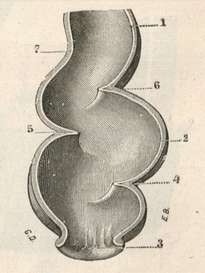|
The rectum is the most distal segment of the large intestine. The word [rectum] arises from the Latin [rectus] and means "straight", such as its use in the name "rectus abdominis" for the "straight muscle of the abdomen". It seems a misnomer, as the rectum of the human species is actually "S" shaped, as seen in the accompanying image. The reason for this discrepancy is that the rectum was named by Galen of Pergamon (129AD - 200 AD) who himself studied this structure in animals such as sheep and goats. In these animals the rectum is indeed straight, and since contradicting Galen was not acceptable (see Michael Servetus), the name has survived until this day. Even Andreas Vesalius has in his 1953 "Fabrica" a depiction of a straight rectum in the human! Click on the bar beneath the image to see Vesalius' image of the rectum. The proximal end of the rectum is not clearly discernible from the sigmoidorectal region, from here the rectum has an "S" shape, measures approximately six to seven inches in length (15 - 17 cm), and it ends distally at the junction of the rectum with the pelvic diaphragm. It is at this point that the anal canal begins. |
 |
| The rectum is characterized by three transverse rectal folds, one on the right side, and two on the left side. These folds are know as the "rectal valves" or the "valves of Houston". The middle rectal fold is known to European anatomists as the "valve of Kohlrausch" Their function in maintaining fecal material in place as well as their function in defecation is still under study. The rectal valves also have a high level of anatomical variation and may not be present at all.
Image source: "Tratado de Anatomia Humana" Testut et Latarjet 8 Ed. 1931 Salvat Editores, Spain |
|
| Back to MTD Main Page | Subscribe to MTD |